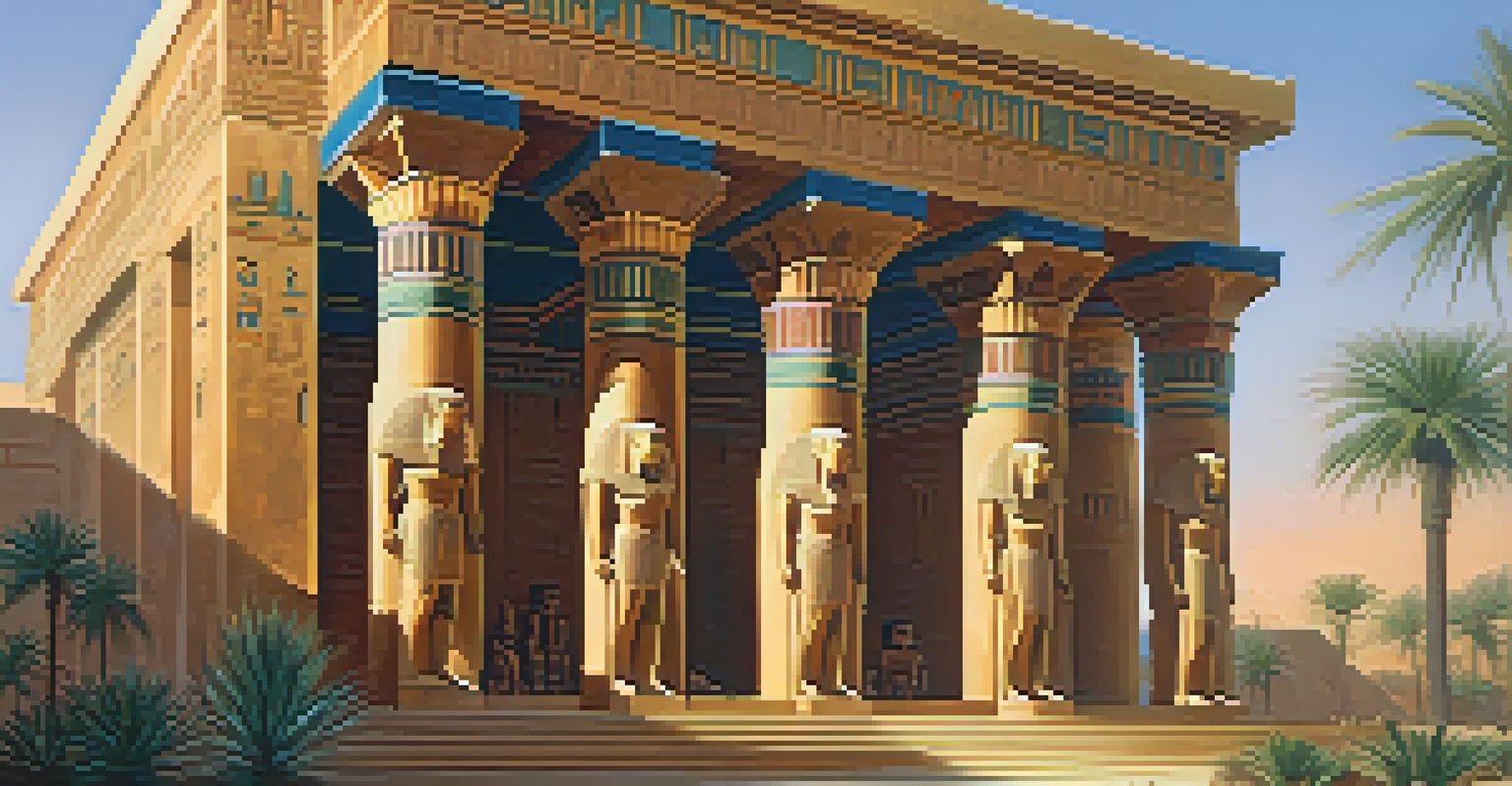The Art of Stone Carving: Techniques from Ancient Egypt

Understanding the Importance of Stone Carving in Egypt
Stone carving held significant cultural and religious importance in ancient Egypt. It was not just a craft; it was a spiritual practice that connected artisans with their gods. The carvings were often used to decorate temples and tombs, serving both aesthetic and functional purposes.
Art is the most beautiful of all lies.
The Egyptians believed that the quality of the stone carvings would influence the afterlife, making the skill even more revered. Each sculpture or relief was a means to communicate with the divine, ensuring that the essence of the deceased could transcend into the next world.
Thus, the art of stone carving was more than mere decoration; it was a crucial component of their religious beliefs and societal structure, influencing how they viewed life and death.
Key Materials Used in Ancient Egyptian Stone Carving
Ancient Egyptian artisans primarily used limestone, granite, and alabaster for their carvings. Limestone was readily available and quite soft, making it easier to work with for detailed carvings. On the other hand, granite, though harder, was prized for its durability and grandeur.

Alabaster, known for its translucent quality, was often used for smaller sculptures and intricate designs. Each stone had its unique qualities, which influenced the choice of material based on the intended purpose of the artwork.
Cultural Significance of Stone Carving
Stone carving in ancient Egypt was not just a craft but a spiritual practice that connected artisans with their gods and played a vital role in religious beliefs.
The decision on which stone to use often reflected the importance of the project, with more prestigious works utilizing the hardest and most beautiful stones available.
Basic Techniques of Stone Carving in Ancient Egypt
Stone carving techniques in ancient Egypt included a variety of methods, primarily chiseling and polishing. Artisans would begin by sketching their designs on the stone surface, using a wooden tool called a stylus. This provided a template for the intricate work that would follow.
The stone carvings are not just artworks; they are a bridge to understanding the soul of ancient civilizations.
Chiseling involved using tools made from copper and later bronze, which allowed for precise cuts and shapes. Artisans would often start with larger tools for rough shaping and gradually switch to finer tools for detailed work, ensuring that every line was perfect.
Finally, polishing was done using harder stones or abrasives to achieve a smooth finish. This meticulous process ensured that the carvings had an impressive, lasting shine that highlighted their artistry.
Symbolism in Ancient Egyptian Stone Carvings
Symbolism played a vital role in ancient Egyptian stone carvings, with many figures and scenes carrying profound meanings. For instance, the ankh symbolized life, while the scarab beetle represented rebirth. Each carved element was intentional, designed to convey messages about the afterlife or honor the gods.
Additionally, the positioning of figures was significant; deities were often depicted larger than humans to denote their power and importance. This hierarchical scale not only conveyed status but also reinforced the belief systems of the time.
Materials Influencing Artistry
The choice of materials like limestone, granite, and alabaster significantly impacted the quality and purpose of the stone carvings, reflecting their importance.
These symbols and their arrangements were essential in communicating the values and beliefs of ancient Egyptian society, creating a visual language that transcended words.
The Role of Artisans in Ancient Egyptian Society
Artisans in ancient Egypt were highly skilled and respected members of society, often working in teams to complete large projects. They were typically organized into guilds, with each artisan specializing in different aspects of stone carving, from design to finishing touches. This specialization allowed for a high level of craftsmanship.
Despite their expertise, artisans were often seen as lower in status than the priests and pharaohs they served. However, their work was crucial in ensuring that temples and tombs were built to honor the divine and commemorate the deceased.
Their legacy lives on, with many carvings still visible today, reminding us of the incredible skills and dedication these artisans brought to their craft.
Evolution of Stone Carving Techniques Over Time
Over the centuries, stone carving techniques in ancient Egypt evolved significantly. Initially, the focus was on simple designs, but as artisans honed their skills, they began to incorporate more complex forms and intricate details. This evolution was driven by cultural shifts and the demands of evolving religious practices.
During the New Kingdom, for instance, there was a notable increase in the quality and quantity of stone carvings, reflecting the wealth and power of the pharaohs. Artisans began to experiment with perspective and depth, moving away from flat representations to more lifelike figures.
Evolving Techniques Over Time
Ancient Egyptian stone carving techniques evolved from simple designs to intricate forms, showcasing the artisans' growing skills and the changing cultural demands.
This evolution not only showcased the technical prowess of the artisans but also highlighted the changing aesthetics and spiritual beliefs of the ancient Egyptians.
Preservation and Legacy of Ancient Egyptian Stone Carvings
The preservation of ancient Egyptian stone carvings has been a remarkable achievement for historians and archaeologists. Many of these artworks have survived millennia due to the durability of the materials used and the dry climate of Egypt. However, preservation efforts continue to be vital to protect these treasures from environmental and human threats.
Modern technology, including 3D scanning and restoration techniques, has played a significant role in conserving these ancient artworks. By digitally documenting the carvings, experts can create replicas and ensure that the original carvings remain intact for future generations to appreciate.

The legacy of these stone carvings is profound, as they provide invaluable insights into the art, culture, and beliefs of ancient Egypt, continuing to inspire artists and historians alike.